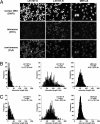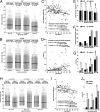High-throughput telomere length quantification by FISH and its application to human population studies
- PMID: 17369361
- PMCID: PMC1828130
- DOI: 10.1073/pnas.0609367104
High-throughput telomere length quantification by FISH and its application to human population studies
Abstract
A major limitation of studies of the relevance of telomere length to cancer and age-related diseases in human populations and to the development of telomere-based therapies has been the lack of suitable high-throughput (HT) assays to measure telomere length. We have developed an automated HT quantitative telomere FISH platform, HT quantitative FISH (Q-FISH), which allows the quantification of telomere length as well as percentage of short telomeres in large human sample sets. We show here that this technique provides the accuracy and sensitivity to uncover associations between telomere length and human disease.
Conflict of interest statement
The authors declare no conflict of interest.
Figures




References
-
- Chan SW, Blackburn EH. Oncogene. 2002;21:553–563. - PubMed
-
- Greider CW, Blackburn EH. Cell. 1985;43:405–413. - PubMed
-
- Flores I, Benetti R, Blasco MA. Curr Opin Cell Biol. 2006;18:254–260. - PubMed
-
- Harley CB, Futcher AB, Greider CW. Nature. 1990;345:458–460. - PubMed
-
- Blasco MA, Lee HW, Hande MP, Samper E, Lansdorp PM, DePinho RA, Greider CW. Cell. 1997;91:25–34. - PubMed
Publication types
MeSH terms
LinkOut - more resources
Full Text Sources
Other Literature Sources

